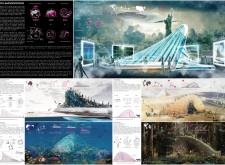5 key facts about this project
POST-ANTHROPOCENE addresses important environmental issues linked to human activity by redefining how people connect with nature. The setting includes a variety of locations, from urban centers to remote ecosystems. Through a series of carefully placed pavilions, each designed for its specific environment, the concept promotes biodiversity and aims to restore ecosystems in distress. The project embodies a commitment to adapting to ecological challenges while reflecting cooperation and symbiosis.
Urban Pavilion
Located in front of the Statue of Liberty, the urban pavilion occupies a significant cultural space. It is designed as an inflatable structure made from recycled plastic, which emphasizes sustainability in urban design. The pavilion not only serves practical purposes but also connects to values of equality and freedom reflected in its iconic backdrop.
Polar Pavilion
In the polar regions, the pavilion takes the form of an ice crystal, aiming to address the ecological threats posed by global warming and overfishing in Antarctica. It uses seawater, which will turn into ice to create a safe habitat for local species during challenging times. Its natural shape mirrors the environment, blending built forms with glacial features that are characteristic of the area.
Ocean Pavilion
The pavilion designed for the Fiji Islands features 3D printed coral reefs, intended to combat overfishing and the introduction of invasive species. Using materials like corn starch and stainless steel powder, this design aims to support marine life by creating new habitats for coral to thrive. The pavilion serves as an architectural response grounded in protecting and nurturing marine ecosystems.
Desert and Jungle Pavilions
In the Sahara, the pavilion is built as a precast mold that offers shelter for desert wildlife. It relies on sand and water, both readily available in this dry region. Meanwhile, the design for the Amazon rainforest utilizes scrap wood to tackle the pressing issue of deforestation. By recycling materials, these structures reduce environmental impact and aid in restoring habitats. They blend into their natural surroundings and underscore a commitment to sustainability.
Each pavilion acts as a response to contemporary ecological needs, reflecting the urgency of protecting the environment. By using local materials and adapting to specific conditions, the design creates an architectural presence that resonates with the current ecological landscape, illustrating the potential of architecture to engage with pressing environmental realities.




















































